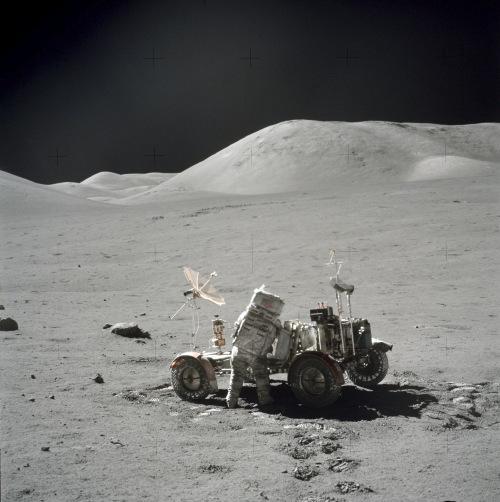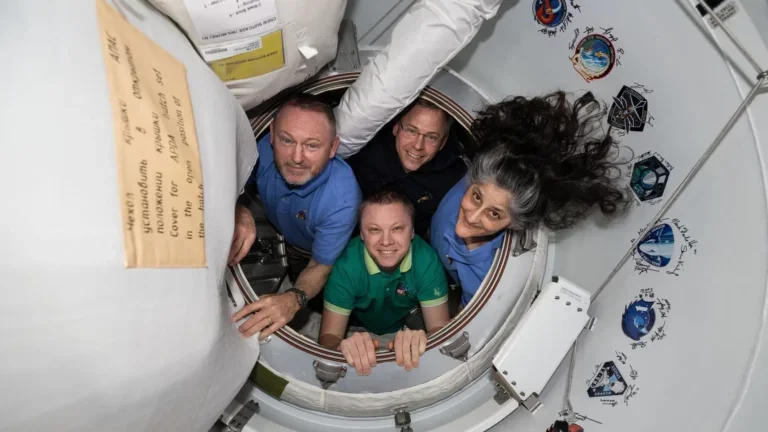Even as a young kid, I understood that spaceflight was about pushing the limits of human experience. Maybe I became aware of the danger when Gemini VIII tumbled out of control after the first-ever docking of two spacecraft in orbit. A quick-thinking Neil Armstrong and David Scott narrowly averted tragedy by using the reentry system to wrestle the capsule back under control.
Or maybe it all became real with the Apollo 1 fire.
Along with much of the world, I was glued to the TV waiting for Apollo 8 to emerge from behind the Moon on Christmas Eve 1968. As a 10-year-old, I listened when Armstrong again demonstrated his skill as a seat-of-the-pants pilot, landing on the Moon with only 15 seconds of fuel to spare.
By all accounts, Apollo 13 should have ended in tragedy. I recall shocked amazement when I first saw a picture of the hole blasted in the side of the Service Module when an oxygen tank exploded. Twenty-five years later, I was visiting Fermilab when a freshly minted particle physics graduate student scoffed at the “preposterous” plot of the newly released Tom Hanks movie. I’m not sure that he believed me when I told him it was a true story.
I cried when I watched Apollo 17 lift off from the Moon, knowing that the last three planned missions had been canceled. I now understand why that decision was inevitable. To the people calling the shots, Apollo was never really about exploration. We went to the Moon to one-up the Soviets in the eyes of the world. Having accomplished that end, each additional flight put that political victory at risk with little perceived gain in status.
But for a generation of young people who watched that drama and went on to become scientists and engineers, Apollo didn’t go to the Moon to beat the Soviets. Apollo went to the Moon for us.
I was saddened by the disaster of space shuttle Columbia. I was livid when it became clear that space shuttle Challenger exploded because someone thought political expediency was more important than physical reality.
I never saw eye to eye with colleagues who bemoaned dollars spent on human spaceflight. While robotic exploration of space is one of humanity’s grandest accomplishments, for many, including myself, robots aren’t enough. It matters that humans see, feel, experience, and push limits. It always has, and it always will. Had you told me at 12 years old that half a century would pass without a return to the Moon, much less a trip to Mars, I probably would have spit in your face. But here we are.

You can follow mankind’s journey to the lunar surface in our free downloadable eBook: Project Apollo: Reaching for the Moon.
But do dreams from childhood ever really die? Call me a romantic, but apparently the answer is no.
When two reusable SpaceX Falcon Heavy boosters landed side by side, I felt hope and longing as much as I did excitement. And, face it: It takes a certain je ne sais quoi to launch your cherry-red electric sports car into Mars-crossing solar orbit with a spacesuit-clad mannequin named Starman in the driver’s seat.
Those were teases; September’s rollout of the shining, bullet-shaped Starship prototype took my breath away. How could the cover artists for all of those 1940s and ’50s science fiction magazines have known?
Robert Heinlein’s The Man Who Sold the Moon was pure fiction, but could Elon Musk become The Man Who Sold Mars? While SpaceX is careful not to say too much about schedules publicly, there is talk on the street of the possibility of a Mars landing within the next five years or so. One even hears that a base could be up and running within the decade. If and when that happens, it seems clear that Musk has no intention of walking away.
This is a struggle. Is all of the recent talk about sending humans to the Moon and Mars a pipe dream? Can Musk — or, for that matter, NASA or Blue Origin — make it so? After a lifetime of resignation, should I again let myself dream of seeing humans on another world?
Could I stop myself if I tried?










